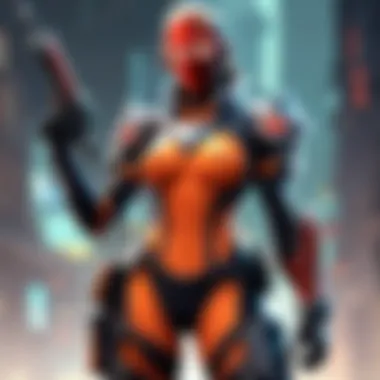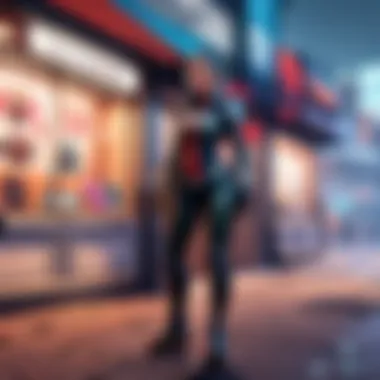Analyzing the Impact of Riot Store on Valorant Community


Game Overview
Preamble to Valorant
Valorant, developed by Riot Games, has swiftly become a shining star in the realm of tactical first-person shooters. It's not just about shooting and strategy; there's a deeper, strategic layer to engage players. Every match is not just a battle but a chess game where every movement and decision can tip the scales. The game’s blend of unique character abilities and classic gunplay sets it apart, creating a fascinating environment for both casual gamers and hardcore players.
Game mechanics and objectives
At its core, Valorant is a team-based game where two squads of five compete against each other. The main game mode involves one team attacking while the other defends bomb sites. The objective is simple: plant the Spike (the game’s version of a bomb) if you're attacking, or defuse it if you are on the defense. But there's more. Communication, strategic planning, and utilizing agents' abilities effectively are crucial. Knowing when to push or hold back can mean the difference between victory and defeat.
Brief history of the game
Valorant entered the gaming scene in June 2020, following a closed beta that saw keen interest from the community. It stepped into a void in the FPS genre, drawing players looking for precision shooting paired with agent abilities. Riot Games' experience from titles like League of Legends undeniably shaped Valorant's success, creating a platform that's continually evolving.
List of playable agents and their unique abilities
Valorant features an eclectic roster of agents, each bringing their flair and unique skills to the battlefield. Examples include:
- Phoenix: A fiery Duelist with abilities to heal himself and create walls of flame.
- Sage: The support player, able to heal allies and revive them with her ultimate ability.
- Sova: A scout who can reveal enemy positions using drone abilities.
The agents not only promote various gameplay styles but also encourage players to think differently about strategy and team composition.
Strategy Guides
Tips for beginners
If you’re just stepping into the world of Valorant, mastering the basics is key. Start by focusing on your crosshair placement, learning the maps, and most importantly, familiarizing yourself with the agents’ abilities. The notion of “slow and steady wins the race” applies here; take your time to learn rather than rushing headfirst into the fray.
Advanced tactics for experienced players
For seasoned players, the game becomes a canvas for creating strategies. Utilizing agent synergies can turn the tide in tough situations. For instance, combining Sage’s slowing abilities with Omen’s teleport can provide unexpected flanking opportunities. Mastering sound cues is also paramount; listening to enemy footsteps can give you vital information that shifts your tactic in an instant.
Map-specific strategies
Maps in Valorant are intricate, each providing unique challenges and opportunities.
- Bind requires understanding teleportation tools for quick rotation.
- Split plays heavily on verticality; controlling the high ground can be a game changer.
Agent-specific tactics and playstyles
Each agent requires a tailored approach. For example, using Jett’s agility to be unpredictable can dominate a match. Alternatively, playing as one of the heavier agents like Brimstone demands a more methodical, defensive playstyle.
Patch Updates
Summary of recent game patches
Riot Games continually tweaks Valorant with regular patches aimed at balancing gameplay. Keeping up with these updates ensures players remain competitive and informed.
Analysis of changes to agents, weapons, and maps
For instance, the recent buffs to Viper made her abilities more effective in controlling space, thus changing team dynamics significantly. Some weapon tweaks can also make a world of difference, especially for players banking on particular rifles or shotguns.
Community feedback on patch notes
Community forums often buzz with opinions post-patch. Some players argue for nerfs, while others have new strategies based on the latest changes. It’s interesting to watch how gameplay evolves based on these updates.
Predictions for upcoming updates
Looking ahead, players speculate on forthcoming updates. Will there be new agents? More maps? Such questions keep the community engaged and vested in the ongoing evolution of the game.
Esports Coverage
Overview of recent Valorant esports events


Esports have taken Valorant to soaring heights. Major tournaments like the VALORANT Champions Tour and the VCT Stage Finals have brought in ocean’s worth of players eager to showcase their skills. The competitive atmosphere is electric, drawing viewers worldwide.
Tournament predictions and analysis
Predicting outcomes in these tournaments is often a guessing game; each team, with its unique style and rhythm, can make or break expectations. Analysts examine past gameplay, player synergy, and meta shifts to forecast which team might take the trophy in the next showdown.
Insights on current professional meta
The meta in Valorant is fluid, shaped by ongoing competitive play. Teams that adapt quickly to strategies and capitalize on new agent strengths often find themselves on top. Keeping an eye on the pros gives a clearer picture of what tactics are in vogue and can be useful for casual players looking to enhance their game.
Player Community
Featured player highlights
The Valorant community is thriving with individual players carving out names for themselves through gameplay, streaming, or creating content. Celebrating these players can inspire others to step up their game.
Community-created content showcase
From fan art to educational YouTube videos, the creativity within the Valorant community knows no bounds. Engaging with these works can add layers to the understanding of the game and foster camaraderie among players.
Forum spotlight on trending topics
Communities on platforms such as Reddit brim with discussion around strategies, highlights from matches, or even grievances about agents. The back-and-forth among players fuels the gaming experience and encourages diverse perspectives within the game.
"Valorant is not just a game; it’s a global community creating a shared culture around competitive play."
In a nutshell, the Riot Store plays a significant role within this ecosystem, offering players additional means to customize and enhance their Valorant experience.
Understanding the Riot Store Framework
In the ever-evolving landscape of video games, the Riot Store serves as a pivotal element that shapes both player experience and game economics. Understanding this framework is essential for anyone keen on deepening their grasp of what makes games like Valorant tick. The Riot Store is not merely a marketplace; it’s a continuum where aesthetics, player identity, and economic activity intertwine.
The Riot Store’s significance lies in its ability to provide players access to an expansive range of digital goods, including skins, battle passes, and event bundles. These offerings are more than just virtual decorations; they signify a player’s commitment to the game while also facilitating community interaction and engagement. The personalization options available allow players to express their individuality, while also creating a sense of belonging within the larger Valorant community.
Historical Context of Riot Store Development
Value-added services in gaming, such as the Riot Store, have roots that can be traced back to the earlier models of downloadable content and microtransactions seen in the gaming industry. Launched alongside games like League of Legends, the Riot Store has witnessed a significant transformation aimed at enhancing player experience. Initially focusing on basic skins, the offerings have evolved into a sophisticated model that combines aesthetic and functional elements that appeal to both casual and competitive gamers.
As the gaming community grew, so did the expectations around in-game purchases. Developers required mechanisms that could both enhance gameplay and generate revenue without compromising on player satisfaction. Riot Games has managed to strike a delicate balance here. Rather than forcing players to spend, the Riot Store encourages voluntary purchases, making it a vital part of the gaming ecosystem.
Key Features of the Riot Store
Diving deeper into the Riot Store reveals several key features that contribute to its attractiveness:
- Diversity of Products: The store doesn't just offer skins; it provides various items, including agents, gun skins, and other cosmetic enhancements, fostering a rich tapestry of choice for players.
- Limited-Time Offers and Events: The incorporation of event bundles introduces urgency and excitement, urging players to act quickly or miss out on unique content. This not only boosts sales during promotional periods but also keeps community engagement vibrant.
- User-Centric Design: Navigational ease is one of the most cornerstone qualities of the Riot Store. Players can easily sift through categories, filtering products by their preferences, making the shopping experience intuitive.
Overall, understanding this framework helps contextualize how and why players engage with the Riot Store. It answers critical questions about not just what players buy, but how those purchases reflect their gaming identity and experiences. Recognizing the importance of this foundation is key as we move forward to explore other dimensions of the Riot Store.
Product Offerings in the Riot Store
In the ever-evolving landscape of online gaming, the Riot Store stands out not merely as a shop for cosmetic items but as a rich repository of virtual possibilities. For players, the products offered here translate into profound expressions of individuality and tactical advantages, thus reshaping their overall gaming experience. This section delves into the diverse array of items available through the Riot Store, aiming to uncover how these offerings shape the gaming environment and player interactions within the Valorant community.
Skins: Aesthetic Versus Functional Considerations
When talking about skins in Riot Store, one can't overlook their dual nature. On one hand, skins are the paragon of visual allure. They breathe life into weapons, giving players a chance to showcase their style and flair. For many, adopting a unique skin can also bolster confidence; after all, who doesn't want to flaunt that glitzy, gold-plated firearm as they dominate in a match?
Yet, players often debate the functional aspect of these skins. While they primarily serve an aesthetic purpose, some may argue that certain skins might distract or even psych out opponents. The psychological edge can be significant in a high-stakes environment like Valorant, where player mentality impacts performance. This leads to an interesting question: do we buy them purely for looks, or is there more to the story?
In essence, the skins act as a canvas for player expression yet interact subtly with the gameplay mechanics and strategies.
Battle Passes: Structure and Rewards
Battle passes in the Riot Store serve as a bridge between casual play and competitive engagement. They offer players the chance to unlock a slew of rewards through participating in challenges and completing missions. It's akin to an adventure map, where the journey through different tiers yields unique skins, sprays, and currency.


Here's how they typically work:
- Free Track: Everyone enjoys a taste of what a battle pass has to offer without spending a dime, making it inclusive to all players.
- Premium Track: For a modest real-world investment, players can access additional tiers that usually house exclusive rewards. The idea here is simple: players spend a bit, and the game throws them exclusive goodies.
The common sentiment among players is that these passes foster a sense of achievement and progression. However, there's often chatter about their perceived value. Some players feel the grind becomes tedious. Striking the balance between enjoyment and obligation is a delicate dance, and one that Riot Games continues to refine based on community feedback.
Event Bundles: Limited-Time Offers
Event bundles make their mark as some of the most anticipated elements within the Riot Store. They drop during specific gaming events, holidays, or significant in-game happenings—think seasonal celebrations or anniversary specials. Often, these bundles feature unique, thematic items that aren’t always available.
A few notable features of these bundles include:
- Exclusivity: Limited-time availability heightens excitement. Players often feel the rush to snag these goodies before they vanish.
- Value Proposition: Many players find that bundles offer great value, combining several items at a discounted price compared to buying each item separately.
- Thematic Cohesion: Event bundles resonate with the ongoing season, creating a deeper connection to the game’s narrative elements.
While these offerings are ephemeral, they cultivate a vibrant culture around the Riot Store and elevate community interaction. Players reminisce about past events and eagerly anticipate each new release, creating a cyclical anticipation that keeps excitement alive.
"In the world of Valorant, every item tells a story; some just dress it up a little better than others."
The Riot Store is not merely a virtual shopping mall but a crucial player in the overarching narrative of the game. The various offerings not only serve practical purposes but also enrich the experience, making each player’s journey uniquely theirs.
User Experience in the Riot Store
In the world of gaming, the user experience can often make or break a player's engagement with a game. The Riot Store, serving as a cornerstone of the Valorant experience, offers an essential insight into how the design, layout, and interactivity can shape player behavior. Focusing on user experience allows us to delve into how these elements are not just about aesthetics but also about functionality and satisfaction. A streamlined approach to navigating the store can significantly enhance a player's journey, making it more enjoyable and less frustrating.
Navigational Ease and Store Layout
When players open the Riot Store, the layout plays a pivotal role in how efficiently they can browse. Imagine entering a cluttered market where everything is jumbled up. Frustrating, right? A well-organized store not only shows off products effectively but also ensures that players can find what they want at the snap of a finger. The Riot Store’s design adopts a clear hierarchy, which, in effect, helps players visually navigate through different categories like skins, battle passes, and event bundles. The top navigation bar is crisp, often featuring highlighted deals or new additions prominently displayed.
Players can quickly move from their favorite skins to event bundles without having to scroll endlessly. This essential navigational ease minimizes the likelihood of overwhelming users—a critical factor since a seamless experience encourages purchases. Properly categorized sections allow both casual gamers and seasoned players to find their desired items without hassle.
Moreover, responsive design is another crucial aspect. As more players choose mobile devices for gaming when the store interface supports easy gestures and quick tapping, it enhances user satisfaction. An agile store layout that works well across devices ensures all players are catered to, creating a more inclusive environment.
Personalization and Player Engagement
Engagement isn’t merely about flashy graphics and bold colors; it’s deeply rooted in personalization. Players are not a monolith; they have various preferences and styles. The Riot Store thrives when it recognizes and responds to these differences. Imagine a player who loves collecting rare skins while another might only be interested in seasonal bundles. When the store tailors its offerings to reflect past purchases or showcases relevant content based on playstyle, it brings users into the fold.
The integration of personalization algorithms can mean the difference between a mundane shopping experience and one that feels curated just for the player. Players often appreciate when they receive recommendations based on their previous interactions. For instance, if a player consistently buys skins for a particular character, providing suggestions that fit their style can elevate their shopping experience. These little touches add a sense of value and connection, greatly enhancing overall satisfaction with both the store and the game.
Furthermore, mechanisms like rewards for frequent visits or purchases can significantly boost engagement. Such incentives keep players coming back for more and contribute to their investment in the game. When players feel heard and valued through personalized experiences, it transforms their relationship with the store.
"A user-centric design in the Riot Store not only fosters loyalty but also creates a community of players engaged in the evolving experience of Valorant."
As we examine the Riot Store’s usability, it's apparent that creating an experience that's intuitive and tailored can be a game-changer. Players who find what they need quickly are more likely to spend time and money within the ecosystem, reflecting on the potent interplay between user experience and potential revenue generation.
Economic Implications of the Riot Store
Examining the economic implications of the Riot Store not only sheds light on its role within the Riot Games ecosystem, particularly in Valorant, but also delves into the broader impact of microtransactions in the gaming industry. A deep understanding of these elements can provide insight into how consumers interact with digital marketplaces, the influence of in-game purchases on gameplay, and the sustainability of game development revenue streams.
The Role of Microtransactions in Game Revenue
Microtransactions have transformed the landscape of video game monetization. The Riot Store, with its plethora of options—like skins, event bundles, and battle passes—presents a prime example of how these small transactions can cumulate into significant revenue.
- Diversified Revenue Streams: Unlike traditional one-time purchase models, microtransactions allow developers to earn continuously as long as the game retains player interest. For Valorant, every skin or cosmetic item bought contributes to the overall revenue, and this model proves lucrative, given the engaged player base.
- Player Spending Behavior: It's fascinating to observe how microtransactions can change player habits. A player may initially intend to spend only a little but often finds themselves investing more over time due to persuasive marketing strategies or limited-time offers.
- Impact on Game Content: Revenue generated from microtransactions allows developers to continue updating and expanding the game. This model not only emphasizes the potential earnings but it aligns the financial success of a game with player satisfaction and ongoing engagement.
Investment Patterns of Players
Investment in digital goods can be quite different from traditional purchasing. In the context of Valorant, this doesn't just pertain to monetary investment but encompasses time, effort, and emotional attachment to the game.
- Psychology of Spending: Many players feel a sense of achievement when acquiring rare skins or event badges. This reinforces the behavior of spending more, as every new item feels like a trophy reflecting one's gaming journey.
- Community Influence: Social factors play a strong role in shaping spending patterns. Online forums and platforms like Reddit often buzz with discussions about the latest skins or in-game offers, influencing purchase decisions. The desire to fit into a community or stand out by showcasing exclusive items can drive players to spend more than they initially planned.
- Sustained Engagement: Players frequently engage with the game if they see themselves as investors. This emotional connection can lead to a habit of continual spending—not merely as a transaction, but as a vested interest in the game's ecosystem.
Comparative Analysis with Other Game Stores
When discussing the Riot Store's economic implications, it's essential to contrast it with other game stores like Steam or Epic Games. Each platform presents its unique take on monetization, affecting player behavior and market dynamics.


- Variety in Offerings: The Riot Store's focus on cosmetic items stands in contrast to platforms like Steam, which might offer a more extensive range of games beyond microtransaction-based monetization. While Steam users may buy outright games or in-game currency, Riot’s approach leans heavily towards microtransactions, showcasing digital goods that do not impact gameplay.
- Market Share and Player Retention: Both the Riot Store and platforms such as Epic Games employ strategic pricing and exclusive offers to retain players. However, Riot Games has a narrower focus, allowing them to create a more tailored experience.
- Player Feedback and Evolution: The responsiveness to community feedback is paramount. The Riot Store continually evolves based on player preferences, adjusting offerings and strategies to maintain its competitive edge. Unlike more generalized platforms, the personal touch from Riot keeps players connected.
It’s clear that the economic implications of the Riot Store are not just about the currency exchanged for skins, but also about the ongoing relationship between players and the game.
In summary, the economic structure of the Riot Store exemplifies modern game monetization, revealing deeper insights into player investment and behavior patterns. Looking ahead, these elements will continute to shape how both players and developers navigate the digital arena.
Community Reactions and Critiques
Understanding community reactions and critiques surrounding the Riot Store is crucial for grasping its place within the gaming experience of Valorant. As players navigate the store, their perceptions and attitudes can significantly influence both the design of in-game offerings and Riot Games’ strategies for player engagement. Feedback from gamers contributes to a lively discourse around the value of virtual items, enabling a glimpse into both the expectations and desires of the community.
Valuation of In-Game Items by Players
In the ever-evolving landscape of gaming, the valuation of in-game items stands as a cornerstone topic among Valorant players. Many consider the worth of a skin not merely in financial terms, but through emotional resonance. This perspective can vary widely; for some, rarity adds to an item's allure. For others, it's about personal connection to the aesthetic or thematic aspects of the skin.
- Scarcity and Demand: New releases, especially limited editions, skyrocket in value and can ignite fierce trading behavior among players.
- Emotional Attachments: Sometimes a skin might be linked to a significant achievement, creating sentimental value that’s difficult to quantify.
- Gameplay Impact: Though skins do not affect performance, their visual appeal can enhance a player's enjoyment, making the gaming experience richer.
As players weigh these aspects, it becomes evident that the value attributed to virtual goods extends beyond mere economics; it's a blend of social identity, community trends, and individual preferences that shapes these valuations.
Feedback Mechanisms and Iterative Improvements
Riot Games has established a feedback loop that allows players to voice their opinions on store offerings and functionality, which is fundamental in shaping future developments. This system operates through various channels, such as social media, forums, and in-game surveys. Players often converge around platforms like Reddit and Facebook, passionately discussing their experiences.
"Feedback is a two-way street; the community speaks, and we listen, ensuring that our offerings are not only desirable but also meaningful to our players."
- Community Feedback: Player reviews often highlight both likes and dislikes, especially regarding price points and item selections. Constructive criticisms lead to tangible changes.
- Iterative Improvements: Riot employs an adaptive model, meaning they are often tweaking elements in response to community feedback. Changes made within a few patches based on player insights can lead to improved formats or new types of items.
- Engagement with Players: Regular updates and direct responses from developers foster trust within the community. Gamers feel they have a stake in the evolution of the Riot Store, encouraging ongoing engagement and loyalty.
In summary, community reactions and critiques play an indispensable role in shaping the Riot Store's future. The valuation of in-game items reflects players' complex relationship with digital goods, while effective feedback mechanisms ensure that their voices are heard, enhancing player experience and loyalty within the Valorant ecosystem.
Future Directions for the Riot Store
As the gaming landscape evolves, so too must the relational dynamics within the Riot Store. Looking ahead, understanding these directions is crucial for grasping how player engagement will continue to shape the ecosystem of Riot Games, particularly with titles like Valorant. The adjustments that the Riot Store may introduce could have significant implications for both gameplay experiences and economic interactions among players.
Emerging Trends in Digital Goods
Digital goods are not just a fleeting fad; they're the new frontier in gaming consumption. Current trends highlight a growing inclination towards unique and customizable items. Gamers increasingly seek not only aesthetic appeal but also personal expression through their in-game possessions. This shift could see Riot Games expanding their offerings to include:
- User-Generated Content: Allowing players to create and sell their own skins or items could foster a vibrant marketplace.
- Dynamic Pricing Models: An adaptive pricing approach could cater to different economic strata within the player base, enhancing accessibility.
- Eco-Conscious Offerings: As environmental awareness rises, items that reflect sustainable practices may garner interest.
These emerging trends suggest a need to balance profitability with player satisfaction, showcasing the adaptive strategies that may ensue.
Potential Expansions and Innovations
The Riot Store may not only adapt but also innovate in several key areas. Possible expansions can be tied to advancements in technology and shifts in player expectations. Some areas worth exploring include:
- Augmented Reality (AR) Features: Integrating AR could offer players a novel way to interact with their items outside the game environment.
- Subscription Models: Instead of paying for individual items, players may appreciate a subscription service that provides exclusive content.
- Cross-Platform Integration: Expanding the Riot Store's offerings across multiple games could streamline purchases for players who engage with various gaming titles.
Looking at what's ahead, the potential for expansions is vast, sparking excitement about how these innovations can enhance the user experience.
"The direction of digital goods and innovations in the Riot Store is critical, as it aligns with the broader shifts in player behavior and technology development."
Closure: The Riot Store's Overall Influence on Valorant
Understanding the Riot Store's impact is paramount for anyone keen on grasping the full landscape of Valorant. It's not just a digital shop where players buy items; it's a thriving ecosystem that shapes how gamers interact with the game in multiple ways. By analyzing the complexity behind its offerings, we can appreciate its influence on gameplay, community engagement, and even the economic models of gaming.
Summary of Findings
Through this exploration of the Riot Store, several key findings emerge:
- Integration of Aesthetics and Utility: Skins and items are not merely visual add-ons. They carry with them a significant social element, impacting how players perceive themselves and each other in matches.
- Revenue Model: The Riot Store represents a substantial source of revenue for Riot Games, allowing for continuous development and improvement of Valorant. With microtransactions becoming a norm, the financial implications are worth examining.
- Community Feedback: Ongoing dialogue between the developers and the player base leads to iterative enhancements, creating a more engaging user experience. Players' voices shape the offerings, promoting a sense of ownership.
- Trends in Digital Goods: Innovations and emerging trends, such as limited-time bundles or exclusive items for events, have the power to revitalize interest and activity within the game.
These factors collectively illustrate the multifaceted nature of the Riot Store.
Final Thoughts on Player Contribution and Engagement
The Riot Store is more than a simple transaction platform; it's a facilitator of player engagement. Contributions from players—whether through purchases or community interaction—wield power in dictating the direction of future content. The investment made by players is not just financial. It creates a loyalty loop, where players feel more invested in the ecosystem.
As players navigate through their choices, they also participate in broader trends in gaming culture. The social interactions that stem from these decisions can enhance the overall gaming experience and create lasting community connections.
In the end, the Riot Store subtly crafts the player journey within Valorant, defining not just how they play, but also how they relate to the game and each other. In this light, the store serves as a critical barometer for the evolving nature of gaming as a whole.



